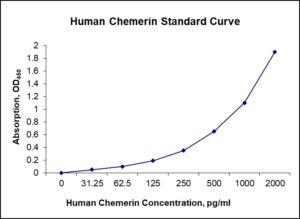Nori Human Chemerin ELISA Kit
$461.00 – $832.00
This ELISA kit is for quantification of chemerin in human. This is a quick ELISA assay that reduces time to 50% compared to the conventional method, and the entire assay only takes 3 hours. This assay employs the quantitative sandwich enzyme immunoassay technique and uses biotin-streptavidin chemistry to improve the performance of the assays. An antibody specific for TIG2 has been pre-coated onto a microplate. Standards and samples are pipetted into the wells and any TIG2 present is bound by the immobilized antibody. After washing away any unbound substances, a detection antibody specific for TIG2 is added to the wells. Following wash to remove any unbound antibody reagent, a detection reagent is added. After intensive wash a substrate solution is added to the wells and color develops in proportion to the amount of TIG2 bound in the initial step. The color development is stopped, and the intensity of the color is measured.
Alternative names for chemerin: retinoic acid receptor responder protein 2 (RARRES2), tazarotene-induced gene 2 protein (TIG2), RAR-responsive protein TIG2
This product is for Laboratory Research Use Only not for diagnostic and therapeutic purposes or any other purposes.
- Description
- How Elisa Works
- Product Citation (0)
- Reviews (0)
Description
Nori Human Chemerin ELISA Kit Summary
Alternative names for chemerin: retinoic acid receptor responder protein 2 (RARRES2), tazarotene-induced gene 2 protein (TIG2), RAR-responsive protein TIG2
| Assay Type | Solid Phase Sandwich ELISA |
| Format | 96-well Microplate or 96-Well Strip Microplate |
| Method of Detection | Colorimetric |
| Number of Targets Detected | 1 |
| Target Antigen Accession Number | Q99969 |
| Assay Length | 3 hours |
| Quantitative/Semiquantitative | Quantitative |
| Sample Type | Plasma, Serum, Cell Culture, Urine, Cell/Tissue Lysates, Synovial Fluid, BAL, |
| Recommended Sample Dilution (Plasma/Serum) | No dilution for sample <ULOQ; sufficient dilution for samples >ULOQ |
| Sensitivity | 6 pg/mL |
| Detection Range | 31.25-2000 pg/mL |
| Specificity | Human chemerin |
| Cross-Reactivity | < 0.5% cross-reactivity observed with available related molecules, < 50% cross-species reactivity observed with species tested. |
| Interference | No significant interference observed with available related molecules |
| Storage/Stability | 4 ºC for up to 6 months |
| Usage | For Laboratory Research Use Only. Not for diagnostic or therapeutic use. |
| Additional Notes | The kit allows for use in multiple experiments. |
Standard Curve
Kit Components
1. Pre-coated 96-well Microplate
2. Biotinylated Detection Antibody
3. Streptavidin-HRP Conjugate
4. Lyophilized Standards
5. TMB One-Step Substrate
6. Stop Solution
7. 20 x PBS
8. Assay Buffer
Other Materials Required but not Provided:
1. Microplate Reader capable of measuring absorption at 450 nm
2. Log-log graph paper or computer and software for ELISA data analysis
3. Precision pipettes (1-1000 µl)
4. Multi-channel pipettes (300 µl)
5. Distilled or deionized water
Protocol Outline
1. Prepare all reagents, samples and standards as instructed in the datasheet.
2. Add 100 µl of Standard or samples to each well and incubate 1 h at RT.
3. Add 100 µl of Working Detection Antibody to each well and incubate 1 h at RT.
4. Add 100 µl of Working Streptavidin-HRP to each well and incubate 20 min at RT.
5. Add 100 µl of Substrate to each well and incubate 5-30 min at RT.
6. Add 50 µl of Stop Solution to each well and read at 450 nm immediately.
Background:
Chemerin, also known as retinoic acid receptor responder protein 2 (RARRES2), tazarotene-induced gene 2 protein (TIG2), or RAR-responsive protein TIG2, is a protein that in humans is encoded by the RARRES2 gene.[1] Chemerin is a chemoattractant protein that acts as a ligand for the G protein-coupled receptor CMKLR1 (also known as ChemR23). Chemerin is a 14 kDa protein secreted in an inactive form as prochemerin and is activated through cleavage of the C-terminus by inflammatory and coagulation serine proteases.[2] Chemerin was found to stimulate chemotaxis of dendritic cells and macrophages to the site of inflammation.[3] Chemerin has been implicated in autocrine / paracrine signaling for adipocyte differentiation and also stimulation of lipolysis.[4] Studies with 3T3-L1 cells have shown chemerin expression is low in pre-differentiated adipocytes[4] but its expression and secretion increases during and after differentiation in vitro. Genetic knockdown of chemerin or its receptor, CMKLR1 impairs differentiation into adipocytes, and reduces the expression of GLUT4 and adiponectin, while increasing expression of IL-6 and insulin receptor. Furthermore, post-differentiation knockdown of chemerin reduced GLUT4, leptin, adiponectin, perilipin, and reduced lipolysis, suggesting chemerin plays a role in metabolic function of mature adipocytes.[5] Studies using mature human adipocytes, 3T3-L1 cells, and in vivo studies in mice showed chemerin stimulates the phosphorylation of the MAPKs, ERK1, and ERK2, which are involved in mediating lipolysis.[5]
References
- Roh SG, et al. (2007). Biochem. Biophys. Res. Commun. 362 (4): 1013–8.
- Zabel BA, et al. (2005). J. Biol. Chem. 280 (41): 34661–6.
- Wittamer V, et al. (2003). J. Exp. Med. 198 (7): 977–85.
- Bozaoglu K, et al. (2007). Endocrinology. 148 (10): 4687–94.
- Goralski KB, et al. (2007). J. Biol. Chem. 282 (38): 28175–88.
Be the first to review “Nori Human Chemerin ELISA Kit”
You must be logged in to post a review.




























Reviews
There are no reviews yet.